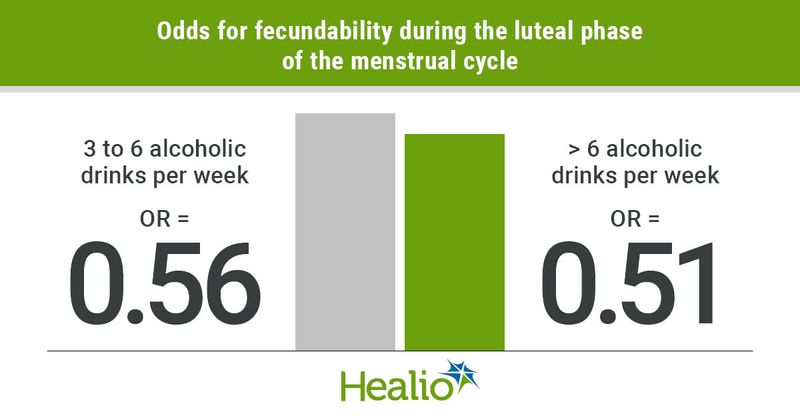Moderate to heavy drinking lowers fecundability odds during luteal menstrual cycle phase
Women who drink more than six alcoholic beverages per week have reduced fecundability compared with those who do not drink alcohol, according to a study published in Human Reproduction.
Kira C. Taylor, PhD, associate professor of epidemiology and population health at the University of Louisville, and colleagues also observed that women who have three to six alcoholic drinks per week have lower fecundability during the luteal phase of the menstrual cycle, and binge drinking and heavy drinking during the ovulatory window greatly reduce fecundability odds.

“Women should avoid alcohol in the second half of the menstrual cycle, and drink less than one drink per day in the first half of the menstrual cycle, if they are trying to conceive,” Taylor told Healio.

Researchers conducted a prospective cohort study of women participating in the Mount Sinai Study of Women Office Workers. The study included women aged 19 to 41 years working for 14 different private and public entities in New York, New Jersey and Massachusetts who were followed up between 1990 and 1994. Participants were interviewed at baseline for demographic and behavioral data, anthropometric characteristics and reproductive history. During follow-up, women completed daily diaries and had urine collection at least 2 days during each menstrual cycle.
Daily diaries contained menstrual cycle characteristics, time of intercourse during the cycle, use of birth control and alcoholic drink intake. One drink was equivalent to 12 oz of beer, 5 oz of wine or 1.5 oz of liquor. Light drinking was equivalent to one to two drinks per week, medium drinking was equal to three to six drinks per week, and heavy drinking was considered having more than six drinks per week.
Heavy drinking reduces fecundability
There were 413 women included in the analysis, of whom 133 became pregnant during a median follow-up time of four menstrual cycles. The median daily alcohol intake was 0.27 drinks per day, or 1.9 drinks per week. Women who were heavy drinkers were less likely to conceive compared with those who did not drink (27% vs. 41%).
During the luteal phase of the menstrual cycle, women who were moderate drinkers (OR = 0.56; 95% CI, 0.31-0.98) and heavy drinkers (OR = 0.51; 95% CI, 0.29-0.89) were less likely to become pregnant compared with those who did not drink. Heavy drinkers also had lower fecundability odds during the ovulatory subphase (OR = 0.39; 95% CI, 0.19-0.72), preovulatory subphase (OR = 0.54; 95% CI, 0.29-0.97) and for the entirety of the menstrual cycle (OR = 0.51; 95% CI, 0.27-0.95). No association was found in those three categories for moderate or light drinkers.
“These results demonstrate a consistent, clinically meaningful and significant association between heavy drinking during the middle to latter part of the menstrual cycle and fecundability,” the researchers wrote. “Results also highlight the importance of the timing element in the association between alcohol intake and fecundability in women. During the luteal phase, a dose-response effect was apparent, with drops in fecundability for even moderate drinkers. During the other phases, the effects for moderate drinking were less consistent and point estimates were not suggestive of linear trend; therefore, caution must be exercised against assuming a linear dose-response association.”
Binge drinking lowers fecundability
For women who engaged in binge drinking, defined as having four or more alcoholic beverages per day, each extra day of binge drinking during a menstrual cycle reduced fecundability odds by 9% (OR = 0.91; 95% CI, 0.81-1). During the ovulatory subphase, each extra day of binge drinking was associated with a 41% reduction in fecundability odds (OR = 0.59; 95% CI, 0.33-0.93) and during the luteal phase, each day of binge drinking lower odds for pregnancy by 19% (OR = 0.81; 95% CI, 0.63-0.98).
“Binge drinking had the largest effect during the ovulatory window, but heavy drinking was associated with reduced chances of pregnancy during all phases of the menstrual cycle, even the preovulatory window,” Taylor said. “Heavy drinking was defined in this study as at least one drink per day on average, which is not what many people would consider heavy. However, this study relied on self-reported alcohol intake, which is often an underestimation of the true alcohol intake.”
Taylor said future research should also measure daily hormone levels to better understand the effect alcohol has on processes related to menstrual function and the preparation of the endometrium for pregnancy.
For more information:
Kira C. Taylor, PhD, can be reached at kira.taylor@louisville.edu.
